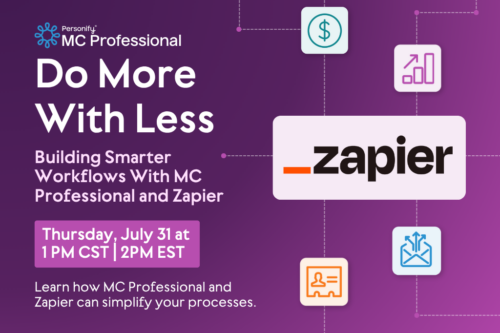Even the biggest nonprofit organizations have a hard time fighting for billboard space against media giants and corporations, which is unfortunate, since charitable organizations are so often the ones taking care of society’s greatest unmet needs. But instead of complaining, there’s something you can do about it: corporate partnerships for nonprofits.
By working with private companies instead of jockeying for attention, you can generate interest, brand awareness, donations, and sponsorships for your organization. At the same time, the corporate partner will see a number of benefits too. Here’s how such partnerships work, the best practices for using them at your organization, and how to get started today.
What are corporate partnerships?
A corporate partnership is what it sounds like: a partnership with a business or corporation in which both parties work together toward a charitable cause. In the typical arrangement, a charity organizes a fundraiser, drive, or other campaign to reach a goal. It may be a one-time deal or an ongoing endeavor. They give the proceeds of the campaign to a designated program or cause.
The corporation, for their part, donates resources of some kind. This often takes the form of cash, but not always. Corporations may also give their time, goods, or services. These are known as “in-kind donations,” a term that applies to any charitable contribution that does not take monetary form.
Note that corporate partnerships for nonprofits are not the same as corporate sponsorship. Though the two share many characteristics, sponsorship is purely financial – a transaction of donation in exchange for brand recognition. This is one aspect of partnership, and a common one. However, partnerships can take other forms as well, discussed below.
Benefits for nonprofits
There exist a number of benefits to partnering with a corporation. These include:
- Brand awareness: Corporations market their charitable contribution as a way of increasing their own brand awareness, the byproduct of which is more recognition for the charitable organization.
- Financial feasibility: Nonprofits rely on fundraising, but may not have the resources to host events themselves. Corporate partnerships can help make those events happen.
- Donations from individuals: When a consumer trusts a company, and that company donates to a certain nonprofit, the consumer may take notice and donate themselves.
- Stability: Economies jump up and down, but corporations are here to stay. Corporate partnerships for nonprofits can help keep nonprofits relevant, even when pocketbooks are closely guarded.
Understanding the corporate partnership landscape
Ecologically minded, social justice-oriented, conscious-bearing consumers all want to see change in the world. This is true on both sides of the aisle and at all age levels, though giving does rise with a rise in household income. People, in other words, always have their eye on how they can help.
This fact is of obvious benefit to nonprofits, who need donations from people to fulfill their mission.
But it is to the benefit of companies as well, who want to be seen as doing good in the world. This makes for a highly charged corporate partnership landscape, in which businesses must work to give back to keep up with their competition. Indeed, products perform better in studies of public perception when people are told that their manufacturers donated to charity.
What does that mean? In a nutshell, that it’s not just you, the nonprofit, who wants a corporate partner. Companies also want nonprofits to bestow a halo effect that will help them beat their rivals when it comes to market share.
Enter corporate partnerships for nonprofits.
Types of corporate partnerships
If you’ve labored under the delusion that there’s only one type of corporate partnerships for nonprofits (and that type is sponsorship), then we have news for you: that’s a tragically limited worldview. The truth is, much greater opportunity exists. Let’s take a look at four of the main types of corporate partnership.
1. Corporate sponsorship
Since it’s the most commonly appreciated type of corporate partnership for nonprofits, let’s tackle sponsorship first. According to Investopedia, this is a very specific relationship: “A corporate sponsorship is a form of marketing in which a company pays for the right to be associated with a project or program.”
Essentially, the company pays the nonprofit money, enabling them to run a program or hold an event. In return, the nonprofit recognizes the company as the event’s sponsor, putting them in promotional materials and emblazoning them on websites and paper collateral.
2. Workplace giving program
In a workplace giving program, companies set up tax-deductible charitable contributions for employees, who can sign up to donate money from their paychecks. Employees have the flexibility to choose the amount and, if the giving program is ongoing, the timing.
3. In-kind donation and skills-based volunteerism
As discussed above, in-kind donations are any type that doesn’t take the form of a financial contribution. Many companies set aside service days to work with nonprofits: building houses, feeding the hungry, digging wells, or helping with dog adoption drives. They may also donate goods to these events, or in general.
In some cases, corporate partnerships for nonprofits may look like donating skills. An accounting firm could donate a day where their employees give free tax prep to the elderly, for instance.
4. Cause marketing
Cause marketing is a term that means both nonprofit and corporate partner are working for the same end. It may overlap other types of corporate partnership, because working for the cause may involve sponsorship, workplace giving, in-kind and skills-based volunteerism, or any combination of the above.
The root of cause marketing is that both entities are trying to achieve a goal or help a certain cause. As with any other type of corporate partnership, both stand to gain recognition and the nonprofit stands to gain donations.
Best practices for nonprofit corporate partnerships
it’s not enough simply to want corporate partnerships for nonprofits. You need to know what you’re getting into, which is where best practices come in. Make sure you:
1. Know what you need
Yes, all nonprofit organizations need money. No, “give us money pleez” is not an effective way to attract corporate partnerships for nonprofits.
Instead, think through exactly what you’re looking for. Do you want to fund a program? Host an event? Give to a specific cause? (Many nonprofits also give to others, often in the form of scholarships.) Then think through how your company can support you. Maybe you need money, or maybe you’d just love to use the grounds of their botanical gardens for free for a night.
2. Prioritize their needs too
Remember, corporate partnerships for nonprofits are two-way streets. What do they need? This is where it’s helpful to find potential business partners whose needs align.
For instance, if your organization is dedicated to feeding the hungry, then a local bread company is a natural partner. They can put your logo on their packaging advertising that they donate to you, while you can get not only monetary but food donations from them.
3. Always check your timing
Time matters. Before you launch any endeavor, make sure it works for both parties. Your organization and theirs should be free of other upcoming commitments or stressors that might detract from what you’re trying to accomplish.
4. Pick a theme
If you’re looking for one-time event sponsorship, your theme will likely relate to the theme of the party. However, you can also pick an ongoing value to focus on together. In the case of the bread company, perhaps you might name your campaign “No Stomach Left Behind.”
5. Create content and promote it
Successful corporate partnerships for nonprofits leverage content, and good branding is a must. You can use your nonprofit’s branding if the corporate sponsor is happy with that, or work together to create a branding package, then use it for content you promote.
6. Designate communication wisely
Both sides must feel they are in the know, or else frustration and resentment can arise. Stay in touch constantly, both about specific upcoming events and in general.
7. Set clear guidelines
Corporate partnerships for nonprofits should always have clear guidelines. How will you get the money or support? How will they get exposure? Use detailed budgets and contracts signed by all.
8. Gather and analyze data
When all is said and done, you need to know what went right and what didn’t. Assign a team to gather data throughout the process – digital traffic, event attendees, donations, etc. – and analyze it. What worked? What needs improvement? Did your event pay for itself and more? And so on.
9. Be prepared for unsolicited offers
It’s no good to pour time and energy into your corporate sponsorship proposals, only to realize you’re completely unprepared if someone comes to you. Always have a plan in place for inbound interest. Who will respond? How? What are the potential campaigns from which a company could choose?
Keep your enthusiasm high and your expectations low, and corporate partnership may become easier than you think.
How can you secure a corporate sponsorship?
Finding event sponsors or ongoing partners is a tough job, but someone’s gotta do it. If you’re going to take on the task of sourcing corporate partnerships for nonprofits, then you must be proactive in your outreach. Passively hoping sponsors will come to you will not work, no matter how hard you hope.
Instead, here are a few ways to build successful corporate partnerships.
Leverage your board members
Companies want to hear from people they respect. Board members are the ultimate in respectability, knowledgeable people in their field who give their time to a good cause despite how busy they are elsewhere. If you can get your board members to reach out and provide a human touch, your sponsorship efforts will go further.
Perfect your sponsorship letter
When trying to find a sponsor, consider putting together a sponsorship package to clarify exactly what you need as well as what you’re offering. This can help crystallize why working with you is to a company’s benefit. In the letter, explain what the money will go toward, anticipate and resolve any potential concerns, and focus on how working together will be mutually beneficial.
Try offering different incentives
Not every company wants the same thing. For instance, some may want you to focus on a single product, while others benefit from more general brand awareness and the halo effect. Make it clear that not only are you open to offering different incentives, but you want to hear ideas from the corporate sponsor.
Talk to friends, family, and other peers
Don’t restrict yourself to the big asks. Sure, it would be great to have Coca-Cola on your side, but if you only go for the Cokes of the world, you’re guaranteed not to get enough funding. You should talk to friends, family, business peers, and other members of your network as well. This will help you gain corporate partnerships for nonprofits at every level.
Respond promptly
When you do hear back from someone, follow up right away. Write a personalized message, from scratch, that pertains directly to the offer you’ve received and outlines next steps.
Writing a nonprofit value proposition
Without a good value proposition, it’s not easy to set up long-lasting, lucrative corporate partnerships for nonprofits. Why? Because the company doesn’t know why they should help you as opposed to any of the hundreds of other organizations who also help the community.
That’s where your nonprofit value proposition comes in. Similar to a member value proposition, this is a statement of the problem that exists and how you aim to serve it. Ideally, a good value proposition will also explain why your nonprofit is better suited to meeting this need than others.
As an example:
Cats for Kids is dedicated to ending petlessness and helping impoverished children experience the joys of pet ownership. We match feline companions with families who want cats but can’t afford them, then provide pet care funds. Unlike other organizations that offer a starter amount, we guarantee a lifetime of good care.
Brand awareness for corporations
If you want to master corporate sponsorship, then you need to understand what’s in it for the business with which you want to partner. Corporate partnerships for nonprofits are all about mutual benefit, so put yourself in the shoes of the company and pretend you’re them. What do you want? How can your nonprofit partner provide it?
Essentially, corporate partners are in it for brand awareness and the halo effect. Your campaign should put their name out there, give them something to brag about to investors or consumers, and make them look good. However, there are a few other benefits, including:
- Financial incentives: Donations are tax deductible.
- Talent: Because many people would rather work at a business that prioritizes social justice and the environment, corporate partnerships can help companies attract and retain better talent.
- Intangibles: Partnerships with nonprofits just make companies look good, which might put them in line for awards, honors, or windfalls of their own.
A few good examples of corporate partnerships
Whether or not you realize it, you see effective corporate sponsorships everywhere you look.
- Pepsi: Pepsi frequently sponsored the NFL halftime show, enabling it to bring in a bigger viewer audience, which is beneficial to both the corporate sports giant and the drinks company. It often sponsors a very specific product. For instance, Pepsi was the 2023-2024 “Official Zero” sponsor, tying the name of their Pepsi Zero Sugar product to the NFL’s move to include 0 as a possible jersey number.
- REI: The famed outdoor clothing and goods company is known around the world for its quality gear and love of adventure. It only makes sense, then, that REI would sponsor the Muddy Buddy Adventure Series, a popular mud run that took place for years. Though they no longer do the run, it’s a perfect example of corporate sponsorship done right.
- Abercrombie & Fitch: The clothing company has partnered with LGBTQ suicide prevention and crisis intervention nonprofit The Trevor Project since 2010, not only carrying the message but donating money to their cause and even designing a gender-neutral limited edition clothing line at one point.
Ways to strengthen nonprofit partnerships
As with onboarding new employees, it’s expensive to start any relationship, and definitely cheaper to make it last than to find a new partner or sponsor. Therefore, once you have secured corporate partnerships for nonprofits, it makes sense to hold onto them if you can.
Accordingly, here are a few ways to strengthen your existing corporate partnerships:
- Keep the lines of communication open, sharing questions, concerns, or new ideas immediately
- Embrace your corporate partner’s vision as well as your own, and bend with them as time goes on (otherwise the relationship might break instead)
- Tailor your marketing messages to mutual goals and renew them every year or as often as needed
- Promote the corporate partner as often as you can, even without a stated reward, to show the relationship is meaningful to you
- Periodically evaluate the partnership to see how it’s going
Final Takeaways
While leveraging the power of corporate partnerships for nonprofits might feel daunting at first, it’s just like anything else: a big goal that you can break down into smaller, more achievable steps. We invite you to use the guide above at your organization to learn more about partnering with companies and get started today.
Questions? Please feel free to get in touch!
















